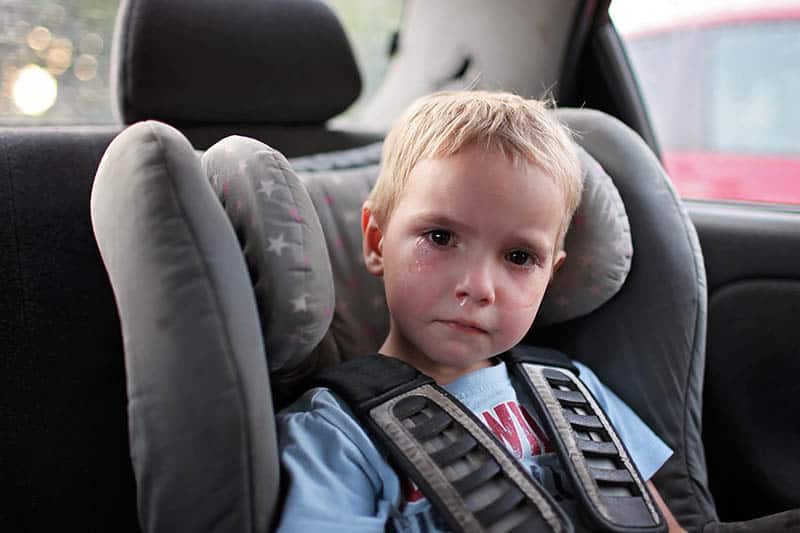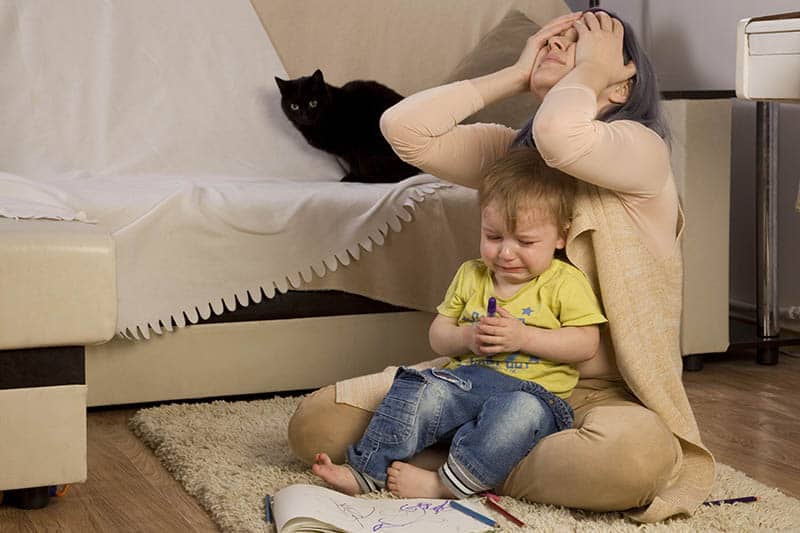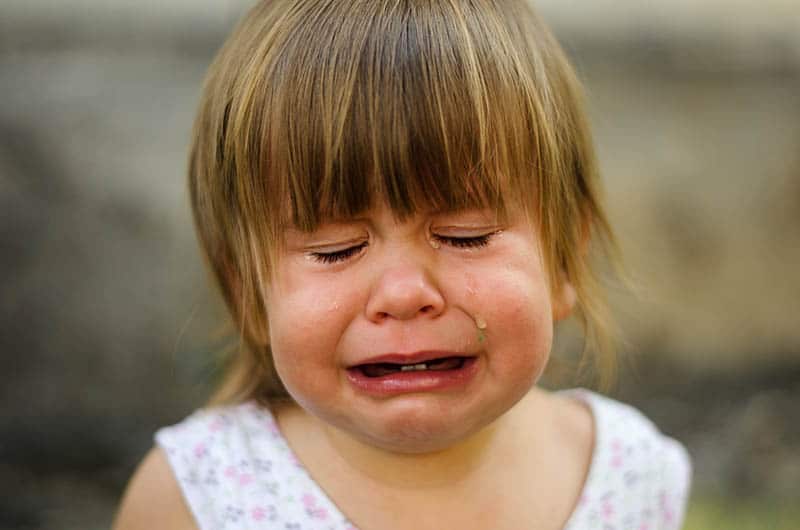Why Do Kids Whine?
Whining children is a tolerable phenomenon – up to a certain point. If your child turns into a crybaby in front of your eyes, it is time to analyze his behavior and take urgent measures so you don’t end up nurturing a pro manipulator.
We as parents are prepared to allow indulgences for our kids, but constant crankiness til the cows come home can certainly stir up many mixed emotions in adults.
For most of us who are unfortunate to have to deal with a whiny baby or toddler (and I’ve had my fair share, trust me!), it’s super frustrating, and sometimes downright annoying!
After putting your little tantrum-prone preschooler through countless time-outs, you reach a point where you’re at an utter loss.
You ask yourself: “What else can I possibly do?!”
After all, shouldn’t whininess become less with age?
It’s difficult for the average parent (who is no certified pediatrician or psychologist) to understand where the boundaries of the norm lie and how to recognize the alarming signs.
Nevertheless, identifying and dealing with whiny behavior in time is extremely important.
After all, no one wants their kid labelled a whiny baby, right?
Let’s be honest here – we often want and expect too much from our children.
You probably dream that your child will quickly learn appropriate behavior and etiquette – the way we grownups do things.
But no matter how much I want my son to get dressed for kindergarten at the same speed as his dad who jumps into his soldier’s uniform, and my little 4-year-old girl to set the dinner table exactly how I told her to, this will not happen.
There’s no point. Just because kids don’t know how to quickly switch from one task to another.
And without this, it won’t work to try adequately assess the situation and their behavior. Tiny humans just aren’t wired that way (yet).
And so it will be right up to school. Until the age of 8, the nervous system in children works according to other principles.
Stimulation processes prevail over restriction processes.
That means it’s difficult for them to calm down and gather themselves, when being upset even over a trifle is much easier.
So, without further ado, let’s take a deeper look at the moods of young children in order to understand where they come from and what we can do about it.
FROM 6 MONTHS TO 1 YEAR OLD

When a baby under the age of 1 whines, it’s difficult for parents to figure out why they’re crying – and therefore even harder to stop.
Common causes of crying in children are associated with basic child needs, such as hunger, tiredness, a diaper change, or if they are in pain.
Oftentimes, it may even be as simple as needing some cuddle time with mom.
The first whims usually begin around the 4-month-old mark.
Whiny baby episodes may be surface out of seemingly nowhere, but take a closer look at the situation.
Try to understand what’s making him so agitated. Is he tired, hungry, or too hot?
Perhaps he’s got trapped wind?
These are all relatively easy fixes: give him a feed, burp him, put him down for a nap, dress him in lighter clothing – you get the gist!
This is also the age where he may start to kick up a bit of a fuss when being put in his car seat or stroller.
Maybe it’s the fact that he can’t see you? Look for strategies to find a solution.
For example, there are some stroller models with the possibility of front-facing or “mom” position, which allow you to have visual contact.
There are some kids who love to watch the world and others who prefer eye contact with their mother.
FROM 1 TO 3 YEARS OLD
80-90% of children at this age have tantrums and whiny episodes.
This is the norm for an average healthy child whose mental development is going smoothly.
Moreover, on the day, your little one can resort to meltdowns anywhere from 10 to 15 times, and there is no need to worry about it.
What we need to remember is your child isn’t yet at the level where he is able to explain what’s happening to him and his child needs – his communication skills are far from developed.
For him, moaning and crying is just a way to express resentment, anger, fear, or discontent. 
Around the 1.5 to 2-year-old mark, the situation gets worse.
There are more bans in his life and his curiosity is ever-growing – such flagrant injustice is enough to drive anyone crazy.
It’s difficult for a toddler’s fragile psyche to come to terms with the fact that an impulsive whim can’t be satisfied right away.
All that remains is to cry, which is what children at this age do. Regularly.
At 2 to 3 years, a crisis comes under the code name “Me, myself, and I!”
RELATED: From Terrible Twos to Terrific Twos
The reasons for this continue to multiply, so it is precisely at this period that the peak of temper tantrums and whininess falls.
Kids want to try everything, but, again, aren’t always allowed to do this.
From this moment, these young children learn to gradually involve adults in their “grief” with the help of crying and moaning in order to achieve their goal.
Fortunately, the method of distraction still works well at this age.
At a critical moment, try to interest your little one with something else to curb the meltdown.
But if you allow such a reaction to gain a foothold, in the future your child may react too sharply to loss or failure.
FROM 3 TO 5 YEARS OLD

He begins to push adults together to probe weaknesses.
Here is a typical example: “Mom, you’re bad, you don’t give candy! And Grammy is good, she brings me chocolates every day.”
All children do this, and this is a natural stage in the development of the psyche.
But depending on your behavior, the child will learn one of two approaches: Either he’ll understand that he needs to obey and will have to negotiate, or he will assume that you can be controlled.
The first, “healthy” scenario will come true if you formulate clear rules for your child and he’ll therefore know that the way he wants it will not always be.
If you break down and begin to give in to all his whims, problematic behavior will quickly become a habit.
You’ll fall into the trap of indulgent parenting.
Feeling that the boundaries can be swung, he’ll be sure that, if you push a little, he will definitely get his way.
Especially often, the tendency to manipulate is fixed in cases when mom and dad strongly differ in educational and disciplinary matters.
Or if you become someone who is easy to bend.
If it seems to you that your toddler is upset over trifles and you consider such behavior disproportionate to the scale of the “disaster,” analyze the situation more deeply.
Instead of accusing him of bad manners, weak character, or inadequacy, think about why your child can’t react differently.
Neither whims nor whininess are born out of thin air. Much depends on parents at this stage.
It’s important to keep in mind that from the age of 3 to 5, kids go through a huge emotional and language development spurt.
They’re actively learning to talk about their needs and understand their feelings.
Your task is to help them improve this primary skill, otherwise it will not form.
If a mother runs to her child at the first squeak, crying will be established as a way of manipulation.
On the flip side of the coin, if she shows emphasized coldness or indifference, tears will provoke a feeling of hopelessness.
At the end of the day, the young child draws his conclusions: Nobody needs me; nobody cares about how I feel; there’s no one to love me; if I call my parents, they won’t come.
From 4 years old onward, whines and tears normally decline.
Many children at this age can already indicate what they want, albeit sometimes very roughly or oddly.
And you can even agree with some of these desires, because their willingness to tolerate a little bit and the ability to accept refusal more often gradually begins to emerge.
From 5 years old and older
At 5 years old, a child should theoretically be able to say clearly and clearly what he feels and what he needs.
But in practice, this is far from always the case.
The long-awaited miracle only happens with a combination of several favorable factors.
First of all, a big return is required from the parents.
In order for their kid to openly talk about his desires and understand what’s happening to him, mom and dad should do the following:
- systematically find time for face-to-face conversations,
- listen carefully to their child, and
- help him recognize emotions from the very beginning, calling and saying them out loud.
Let’s be realistic. Not all of us are ready to invest so many resources in children.
The state of the nervous system also has to be taken into account.
Many modern children, both at 4 years old and at 5 years old, have speech delays of varying severity.
And for the kid who can’t clearly express his thoughts, living in society is very difficult.
Total misunderstanding on the part of others makes him very sharply and emotionally respond to prohibitions.
At first he begins to get angry and then cry with frustration.
If for some reason tantrums by the age of 5 have not disappeared, this behavior risks being entrenching as a way of manipulation.
And tears will almost certainly become an instrument of influence on others.
The consequences are very unpleasant – not only for the parents, but more importantly, the child.
Do you like to be manipulated? It’s safe to say no one’s a fan.
Manipulation, whatever it may be, always has an unchanged ending: The “experimenter” sooner or later begins to feel irritation, and then anger or hate towards the “aggressor.” What’s the outcome?
Manipulative kids won’t make friends.
And at school it will be especially difficult for them to adapt (for example, because he will perceive failures as the end of the world.)
After all, it’s one thing to stay at home and “train” mom, but quite another to go to school and try to “build” teachers and peers.
Boys Don’t Cry!

Looking at his tearful son, Dad either openly condemns him in this gender betrayal, or in despair, he is discouraged.
By the way, in the second scenario, the boy feels and reads everything perfectly.
Well, almost all dads like to compare sons with themselves in childhood, and with other boys too.
With those that never cry, naturally.
In fact, they completely ignore their child’s feelings – partly due to the fact that they’re unable to hear their own.
The trouble is that such a tactic only strengthens the son’s confidence in his own powerlessness, weak character, and incompetence.
And if the boy is hypersensitive by nature, then the father’s demand to be an iron leader can even turn into a tragedy.
After all, as he is, Dad doesn’t need him, and for the sake of his father, he’ll have to become a completely different person.
Only by recognizing and realizing your feelings can you overcome yourself without developing related complexes.
It would be great if we let the boys cry today already and instill in them the following attitude: “Yes, now I’m crying because I am upset/hurt/scared. But I will try to cope with it! And I will surely succeed.”
What Should A Parent Of A Whining Child Do?

These tips will help you react correctly to whining children‘s tears and act wisely during a “hurricane.”
Analyze the circumstances in which your baby or young child resorts to tears.
If you discover that he has a speech delay, you’ll need to get him to a neurologist and speech therapist – and don’t be afraid to get a second opinion if you feel that your child’s need isn’t being addressed.
If you realize that you yourself have allowed your child to manipulate others, you’ll have to change your tactics.
Hysteria in the vast majority of cases is supported by the presence of spectators.
If your child whines or throws temper tantrums in crowded places, stop reporting, scolding, and punishing.
Each time, begin by leading him to a place where there will be no one besides the two of you.
This is to prevent the development of hysteroid traits, especially in anxious children, and it shouldn’t be neglected.
If you clearly realize at that moment your child is trying to manipulate you with the help of tears and/or moans, do not pity him and try persuade him to calm down.
Gather all your will and don’t succumb to provocation. It’s important to work on yourself because it will make you a better mom.
Recall how you generally react to your child whining: do you get angry, scream, fall into a stupor, start to get very worried?
Or do you want only one thing – to console him as soon as possible?
All these emotions come from childhood and speak to how our own parents behaved with us in similar situations.
The burden of the past makes it very difficult to react appropriately – that is, calmly – to children’s tears.
When we’re consumed by our own emotions, the child also feels them.
And he begins to worry, not only because he did something wrong, but also because his mother was very upset or angry.
If there’s one take-away from this article, remember this:
The stronger you turn on emotionally, the harder it is for a child to calm down.
In moments when the child is in full meltdown mode, the adult must maintain the position of the observer.
To explain, this is when you impartially comment on what you see: “You’re crying because you’re upset. You liked the dolly in the store, but I can’t buy it for you now.”
The position of the observer is the only way to assess the situation appropriately and to ascertain if there’s danger to the life or health of the child in this particular case or if it’s pure manipulation.
It seems like such a simple thing, but to maintain a neutral position is not so simple. Being a mom is hard work.
To stop acting on the old template – it clearly doesn’t work, else you wouldn’t be needing to read this article.
Remember which of your friends know how to cope with children’s whims.
In difficult moments, mentally ask yourself what they would say and what they would do?
So you will quickly adjust your tactics.
READ NEXT: Happy Parenting Guide: 10 Tips For Raising Happy Children
Like this article? Please share or pin it for later. You can also stay in the loop and follow me on Facebook, Instagram or Pinterest.

This post contains affiliate links. Please see our full disclosure for more info.

